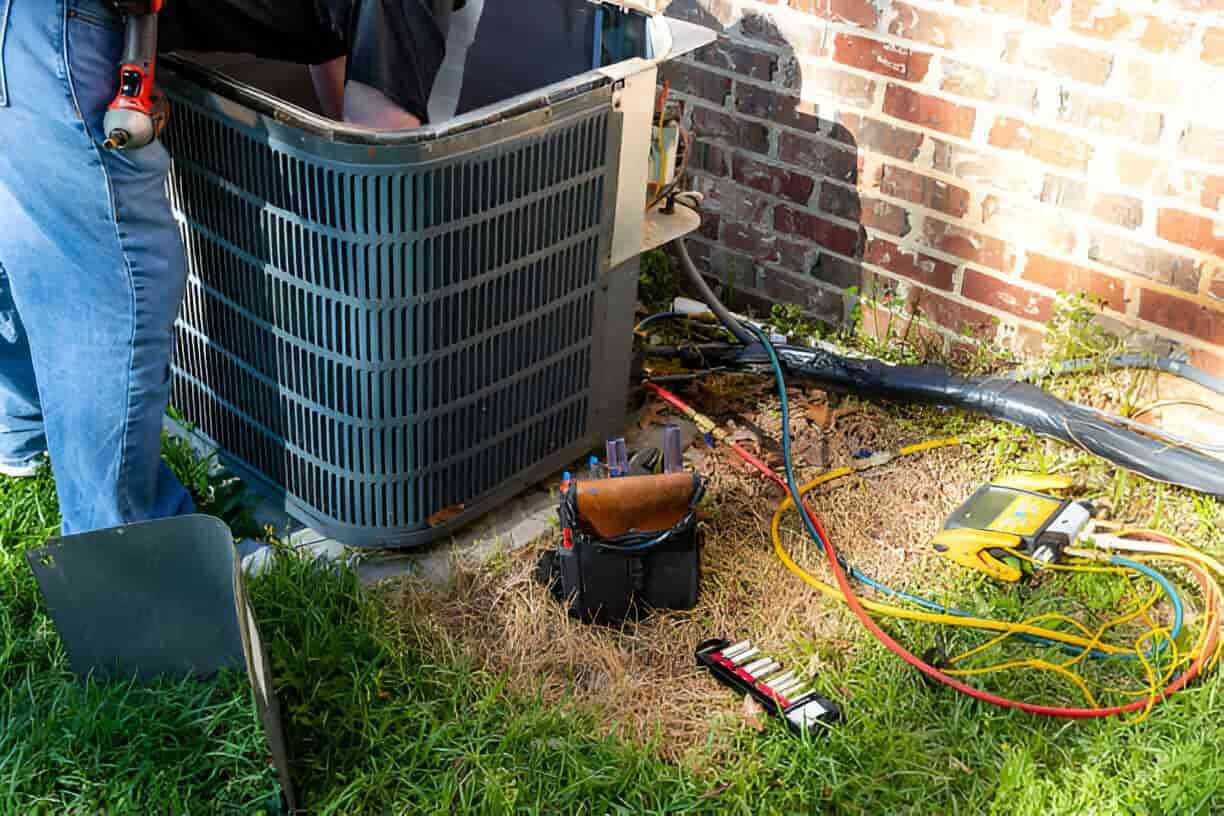AC Repair in Lakeland, FL


Common AC problems in Lakeland homes and businesses
- No cooling or weak cooling
Unit runs but does not reach set temperature. Common causes: low refrigerant, failing compressor, clogged coil, or airflow restrictions from dirty filters and ductwork. - Short cycling or frequent on-off cycles
System starts and stops repeatedly. Often caused by thermostat issues, refrigerant imbalance, or an overworked compressor. Short cycling increases wear and energy use. - Frozen evaporator coil
Ice on the indoor coil usually indicates restricted airflow, low refrigerant, or a failing blower motor. In Lakeland’s humidity, restricted airflow accelerates icing. - Leaking water or clogged drain lines
Standing water or stains near the indoor unit commonly result from clogged condensate drains, damaged pans, or improper unit tilt. - Strange noises or vibrations
Rattles, squeals, or banging can signal loose panels, failing bearings, fan motor problems, or failing compressor mounts. - High indoor humidity or musty odors
Poor dehumidification in humid climates like Lakeland can be caused by incorrect refrigerant charge, oversized equipment cycling too fast, or microbial growth in coils and drip pans. - Electrical issues and tripped breakers
Repeated breaker trips point to compressor lock-up, short circuits, capacitors or contactor failure, or improper wiring.
How a professional diagnostic works
A methodical diagnosis isolates the root cause rather than just treating symptoms:
- Initial inspection of outdoor and indoor units, ducts, air handler, and thermostat settings.
- Airflow measurement and filter condition check to identify restrictions.
- Electrical testing of capacitors, contactors, motors, and safety switches with diagnostic meters.
- Refrigerant checks using gauges to confirm proper charge and leak detection equipment if levels are low.
- Coil and drain inspection for blockages, corrosion, or biological growth.
- System performance test to verify cooling capacity and confirm component operation under load.
Technicians document findings, explain options in plain language, and identify whether a repair, part replacement, or full system replacement is the most reliable course.
Parts replacement and component repair
Common serviceable parts and typical repair considerations:
- Capacitors and contactors — frequent failure points; replacement usually restores startup reliability.
- Compressor — major component; sometimes repairable but often replaced when internally damaged or very inefficient.
- Motors and fans — blower and condenser motors wear from heat, humidity, and debris buildup.
- Coils and fin straightening — coils can corrode or get blocked; cleaning or coil replacement may be required.
- Thermostats and control boards — modern digital controls can fail and affect system sequencing.
- Refrigerant lines and valves — leaks require repair, evacuation, and recharging to proper spec.
Important note for Lakeland systems: many older systems use R-22 refrigerant, which is phased out and increasingly difficult to service. For R-22 systems, technicians will advise on repair feasibility versus upgrading to R-410A or a new system for long-term reliability.
Emergency and same-day response options
Rapid response is crucial during extreme heat or for commercial operations:
- Same-day service commonly includes an initial on-site diagnosis and immediate fixes for simple issues such as capacitors, filters, or thermostat replacements.
- Emergency repair options cover major failures that pose health or safety risks, like complete system loss in medical, retail, or hospitality settings.
- Expect a technician to arrive ready to perform a full diagnostic and to carry common replacement parts for rapid turnaround. For larger components or replacements, scheduling and parts availability will determine next steps.
Estimated repair timelines and what affects them
- Diagnostic visit: 30 to 90 minutes depending on system complexity.
- Minor repairs (capacitor, contactor, filter, thermostat): typically completed within a few hours.
- Moderate repairs (motor replacement, coil cleaning, refrigerant leak repair): several hours to most of a day.
- Major repairs or compressor/coil replacement: half day to a full day; may require ordering parts and scheduling follow-up.
- Commercial system repairs: can take longer due to larger equipment, multi-zone systems, and safety permitting.
Timelines depend on parts availability, system accessibility, age of equipment, and whether refrigerant types need special handling.
Warranty and parts information
- Manufacturer warranties often cover major components like compressors for a set period; durations vary by brand and model.
- Labor warranties provided by service providers may cover workmanship for a defined period after repair.
- OEM versus aftermarket parts: OEM parts typically maintain manufacturer warranty compliance and offer predictable longevity; aftermarket parts may be a cost option but can affect warranty.
- Keep records of maintenance and repairs to preserve warranty claims. For systems using phased-out refrigerants, part availability and warranty implications should be reviewed before repair.
Preventive steps to avoid future breakdowns in Lakeland
- Seasonal maintenance before peak summer demand: clean coils, check refrigerant, inspect electrical components, and test controls.
- Change or clean filters monthly in high-use periods to maintain airflow and indoor air quality.
- Keep condensate drains clear and consider a secondary drain or float switch for protection in high-humidity conditions.
- Provide shade for outdoor condensers without restricting airflow to reduce workload during heat.
- Address small issues promptly: a humming motor or a stuck damper can escalate quickly in a hot, humid climate.
- Consider system sizing and dehumidification: oversized systems can short cycle and underperform at humidity control; a right-sized, properly zoned system reduces wear.
- Regular duct inspections for leaks and insulation problems that reduce efficiency and comfort.
Why timely AC repair matters in Lakeland, FL
Delaying repair in Lakeland’s climate increases energy bills, shortens equipment life, and raises the risk of indoor humidity and mold problems. For businesses, system downtime affects operations, inventory, and customer comfort. Prompt, skilled repair restores performance quickly and is often more cost-effective than emergency replacement after a catastrophic failure.
Professional AC repair in Lakeland, FL addresses root causes, protects system value, and adapts solutions to local climate demands—keeping homes and businesses comfortable and operational through peak summer conditions.
Service Areas


